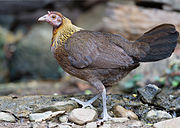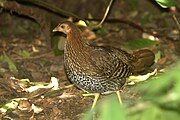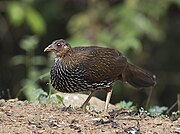Junglefowl
| Junglefowl Temporal range:
| |
|---|---|

| |
| Grey junglefowl (G. sonneratii) hen | |
| Scientific classification | |
| Domain: | Eukaryota |
| Kingdom: | Animalia |
| Phylum: | Chordata |
| Class: | Aves |
| Order: | Galliformes |
| Family: | Phasianidae |
| Tribe: | Gallini |
| Genus: | Gallus Brisson, 1760 |
| Type species | |
| Phasianus gallus[1] Linnaeus, 1758
| |
| Species | |
| |
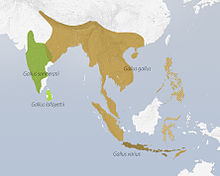
| |
Gallus gallus Gallus lafayettii Gallus sonneratii Gallus varius
| |
Junglefowl are the only four living species of bird from the genus Gallus in the bird order Galliformes, and occur in parts of South and Southeast Asia. One of the species in this genus, the red junglefowl, is of historical importance as the direct ancestor of the domestic chicken, although the grey junglefowl, Sri Lankan junglefowl and green junglefowl are likely to have also been involved.[2] The Sri Lankan junglefowl is the national bird of Sri Lanka. They diverged from their common ancestor about 4–6 million years ago.[2] Although originating in Asia, remains of junglefowl bones have also been found in regions of Chile, which date back to 1321–1407 CE, providing evidence of possible Polynesian migration through the Pacific Ocean.[3]
The junglefowl are omnivorous, eating a variety of leaves, plant matter, invertebrates such as slugs and insects, and occasionally small mice and frogs. These are large birds, with colourful plumage in males, but are nevertheless difficult to see in the dense vegetation they inhabit.
As with many birds in the pheasant family, the male takes no part in the incubation of the egg or rearing of the precocial young. These duties are performed by the drab and well-camouflaged female. Females and males do not form pair bonds; instead, the species has a polygynandrous mating system in which each female will usually mate with several males. Aggressive social hierarchies exist among both females and males, from which the term "pecking order" originates.
Taxonomy
[edit]The genus Gallus was erected by the French scientist Mathurin Jacques Brisson in his Ornithologie published in 1760.[4] The type species is the red junglefowl (Gallus gallus).[5] The Swedish naturalist Carl Linnaeus had introduced the genus Gallus in the 6th edition of his Systema Naturae published in 1748,[6] but Linnaeus dropped the genus in the important tenth edition of 1758 and put the red junglefowl together with the common pheasant in the genus Phasianus.[7][8] However, the red junglefowl and common pheasant are now known to have diverged about 18–23 million years ago, and belong to different subfamilies.[2] This pairwise divergence time was also the same between the other three junglefowls and the pheasant.[2] As the publication date of Linnaeus's sixth edition was before the 1758 starting point of the International Commission on Zoological Nomenclature, Brisson and not Linnaeus is considered as the authority for the genus.[9]
| |||||||||||||||||||||
| Cladogram showing the species in the genus Gallus.[2][10] |
More recent phylogenetic evidence supports the closest relatives of Gallus being the bamboo partridges in the genus Bambusicola, from which they diverged about 15 million years ago.[11]
Extant species
[edit]The genus contains four species.[12]
| Common name | Scientific name and subspecies | Range | Size and ecology | IUCN status and estimated population |
|---|---|---|---|---|
| Red junglefowl | Gallus gallus (Linnaeus, 1758) |
India, Pakistan, eastwards across Indochina and southern China and into Malaysia, Singapore, Philippines and Indonesia
|
Size: Habitat: Diet: |
LC
|
| Sri Lankan junglefowl | Gallus lafayettii Lesson, 1831 |
Sri Lanka
|
Size: Habitat: Diet: |
LC
|
| Grey junglefowl | Gallus sonneratii Temminck, 1813 |
Indian Peninsula, but extends into Gujarat, Madhya Pradesh, south Rajasthan, and Pakistani Punjab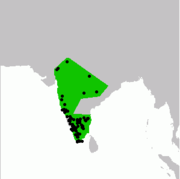
|
Size: Habitat: Diet: |
LC
|
| Green junglefowl | Gallus varius (Shaw, 1798) |
Java, Bali, Lombok, Komodo, Flores, Rinca, and small islands linking Java with Flores, Indonesia | Size: Habitat: Diet: |
LC
|
Fossil record
[edit]Prehistorically, the genus Gallus was found all over Eurasia; in fact, it appears to have evolved in southeastern Europe. Several fossil species have been described, but their distinctness is not firmly established in all cases:
- Gallus aesculapii (Late Miocene/Early Pliocene of Greece) - possibly belongs into Pavo[14]
- Gallus moldovicus (Late Pliocene of Moldavia) - sometimes misspelt moldavicus, may be synonym of Pavo bravardi[14]
- Gallus beremendensis (Late Pliocene/Early Pleistocene of Eastern Europe)
- Giant junglefowl Gallus karabachensis (Early Pleistocene of Nagorno-Karabakh)
- Gallus tamanensis (Early Pleistocene? of Taman Peninsula)
- Gallus kudarensis (Early/Middle Pleistocene of Kudaro, South Ossetia)
- Gallus europaeus (Middle Pleistocene of Italy)
- Gallus sp. (Middle/Late Pleistocene of Trinka Cave, Moldavia)
- Gallus imereticus (Late Pleistocene of Gvardjilas-Klde, Imeretia)
- Gallus meschtscheriensis (Late Pleistocene of Soungir, Russia)
- Gallus georgicus (Late Pleistocene - Early Holocene of Georgia)
- Gallus sp. (Late Pleistocene of Krivtcha Cave, Ukraine)
- Gallus sp. (Early Holocene of Dnieper region)
References
[edit]- ^ "Phasianidae". aviansystematics.org. The Trust for Avian Systematics. Retrieved August 5, 2023.
- ^ a b c d e Lawal, R.A.; et al. (2020). "The wild species genome ancestry of domestic chickens". BMC Biology. 18 (13): 13. doi:10.1186/s12915-020-0738-1. PMC 7014787. PMID 32050971.
- ^ Storey, Alice (June 2007). "Radiocarbon and DNA Evidence for a Pre-Columbian Introduction of Polynesian Chickens to Chile" (PDF). Proceedings of the National Academy of Sciences. 104 (25): 10335–10339. Bibcode:2007PNAS..10410335S. doi:10.1073/pnas.0703993104. PMC 1965514. PMID 17556540.
- ^ Brisson, Mathurin Jacques (1760). Ornithologie, ou, Méthode contenant la division des oiseaux en ordres, sections, genres, especes & leurs variétés (in French and Latin). Vol. 1. Paris: Jean-Baptiste Bauche. Vol. 1, p. 26, Vol. 1, p. 166.
- ^ Peters, James Lee, ed. (1934). Check-list of Birds of the World. Vol. 2. Cambridge, Massachusetts: Harvard University Press. p. 118.
- ^ Linnaeus, Carl (1748). Systema Naturae sistens regna tria naturae, in classes et ordines, genera et species redacta tabulisque aeneis illustrata (in Latin) (6th ed.). Stockholmiae (Stockholm): Godofr, Kiesewetteri. pp. 16, 28.
- ^ Linnaeus, Carl (1758). Systema Naturæ per regna tria naturae, secundum classes, ordines, genera, species, cum characteribus, differentiis, synonymis, locis (in Latin). Vol. 1 (10th ed.). Holmiae (Stockholm): Laurentii Salvii. p. 158.
- ^ Allen, J.A. (1910). "Collation of Brisson's genera of birds with those of Linnaeus". Bulletin of the American Museum of Natural History. 28: 317–335. hdl:2246/678.
- ^ . "Article 3". International Code of Zoological Nomenclature (4th ed.). London: International Trust for Zoological Nomenclature. 1999. ISBN 978-0-85301-006-7.
- ^ Tiley, G.P.; Pandey, A.; Kimball, R.T.; Braun, E.L.; Burleigh, J.G. (2020). "Whole genome phylogeny of Gallus: introgression and data‑type effects". Avian Research. 11 (7). doi:10.1186/s40657-020-00194-w.
- ^ "Galliformes". bird-phylogeny (in German). Retrieved August 2, 2021.
- ^ Gill, Frank; Donsker, David, eds. (2017). "Pheasants, partridges & francolins". World Bird List Version 7.3. International Ornithologists' Union. Retrieved November 22, 2017.
- ^ IOC World Bird List 13.1 (Report). doi:10.14344/ioc.ml.13.1.
- ^ a b Mourer-Chauviré, Cécile (1989). "A peafowl from the Pliocene of Perpignan, France" (PDF). Palaeontology. 32 (2): 439 – via The Palaeontological Association.
- Steve Madge; Philip J. K. McGowan; Guy M. Kirwan (2002). Pheasants, Partidges and Grouse: A Guide to the Pheasants, Partridges, Quails, Grouse, Guineafowl, Payton Moore, Buttonquails and Sandgrouse of the World. A&C Black. ISBN 978-0-7136-3966-7.
External links
[edit] Media related to Gallus at Wikimedia Commons
Media related to Gallus at Wikimedia Commons


